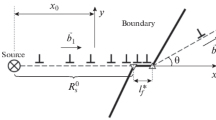Abstract
Typical configurations of broken dislocation boundaries formed during plastic deformation at faceted grain boundaries have been analyzed. The reasons for their formation have been determined. It has been shown that the shape and sizes of strain-induced broken dislocation boundaries can be determined by the geometry of a faceted boundary and the relevant slip systems of lattice dislocations. The calculations carried out in the framework of the 2D model make it possible to explain the morphology of the observed broken dislocation boundaries.
Similar content being viewed by others
References
V. V. Rybin, Large plastic deformation and fracture of metals (Metallurgiya, Moscow, 1986).
Q. Liu and N. Hansen, “Microsructural study of deformation in grain boundary region during plastic deformation in polycrystalline aluminium,” Mater. Sci. Eng., A 234–236, 672–675 (1997).
Y. Estrin and A. Vinogradov, “Extreme grain refinement by severe plastic deformation: A wealth of challenging science,” Acta Mater. 61, 782–817 (2013).
V. V. Rybin, A. A. Zisman, and N. Yu. Zolotorevskii, “Junction disclinations in plastically deformable polycrystals,” Fiz. Tverd. Tela 27, 181–186 (1985).
A. E. Romanov and A. L. Kolesnikova, “Application of disclination concept to solid structures,” Prog. Mater. Sci. 54, 740–769 (2009).
V. V. Rybin, V. N. Perevezentsev, and Yu. V. Svirina, “Model of formation of broken dislocation boundaries at joint disclinations,” Tech. Phys. 6, 8980–903 (2016).
A. E. Romanov and V. I. Vladimirov, “Disclinations in Crystalline Solids,” in Dislocations in Solids, Vol. 9, Ed. by F. R. N. Nabarro (Elsevier, Amsterdam, 1992), pp. 191–402.
V. V. Rybin, V. N. Perevezentsev, and Yu. V. Svirina, “The physical model of the initial stages of fragmentation of polycrystals during the developed plastic deformation,” Phys. Met. Metallogr. (2017) (in press).
V. V. Rybin, V. N. Perevezentsev, and Yu. V. Svirina, “Structural transformations at the initial stages of fragmentation of plastically deformed polycrystals; A Computer experiment,” Tech. Phys. 5, 745–754 (2017).
V. N. Perevezentsev, Yu. V. Svirina, and S. V. Kirikov, “Simulation of dislocation structures formed during plastic deformation in the elastic field of disclination under different conditions of dislocation generation,” Def. Razrush., No. 3, 2–8 (2017).
E. A. Rzhavtsev and M. Yu. Gutkin, “The dynamics of dislocation wall generation in metalls and alloys under shock loading,” Scr. Mater. 100, 102–105 (2015).
V. N. Perevezentsev, G. F. Sarafanov, and J. V. Svirina, “Computer simulation of the dislocation ensemble kinetics in the elastic fields of mesodefects and fragmentation processes during plastic deformation,” Mater. Phys. Mech. 21, 78–98 (2014).
V. N. Perevezentsev and G. F. Sarafanov, “The screening of mesodefects stress fields by dislocation ensemble and misorientation structure formation during plastic deformation”, Rev. Adv. Mater. Sci. 30, 7–89 (2012).
Ch. V. Kopetskii, A. N. Orlov, and L. K. Fionova, Grain boundaries in pure materials (Nauka, Moscow, 1987).
G. I. Taylor, “Plastic strain in metals” J. Inst. Met. 62, 307–324 (1938).
A. A. Zisman and V. V. Rybin, “Basic configurations of interfacial and junction defects induced in a polycrystal by deformation of grains,” Acta Mater. 44, 403–407 (1996).
E. Van der Giessen and A. Needleman, “Discrete dislocation plasticity: A simple planar model,” Modell. Simul. Mater. Sci. Eng. 3, 689–735 (1995).
Author information
Authors and Affiliations
Corresponding author
Additional information
Original Russian Text © V.V. Rybin, V.N. Perevezentsev, S.V. Kirikov, 2018, published in Fizika Metallov i Metallovedenie, 2018, Vol. 119, No. 5, pp. 444–452.
Rights and permissions
About this article
Cite this article
Rybin, V.V., Perevezentsev, V.N. & Kirikov, S.V. Formation of Strain-Induced Broken Dislocation Boundaries at Faceted Grain Boundaries. Phys. Metals Metallogr. 119, 421–429 (2018). https://doi.org/10.1134/S0031918X18050125
Received:
Accepted:
Published:
Issue Date:
DOI: https://doi.org/10.1134/S0031918X18050125




